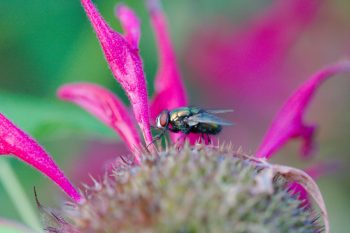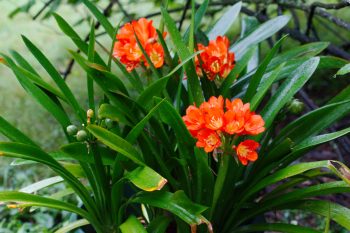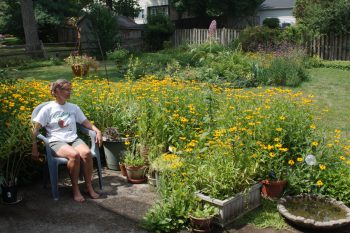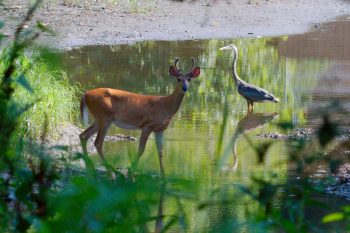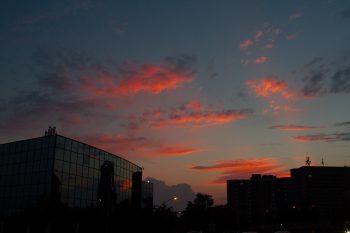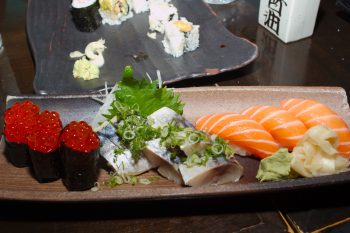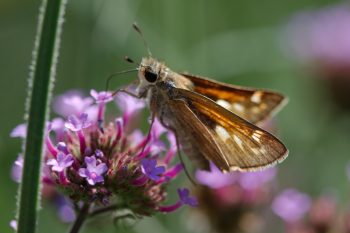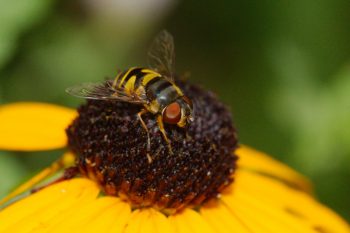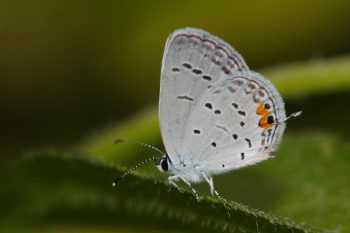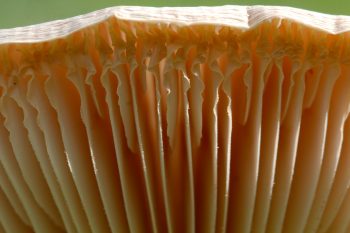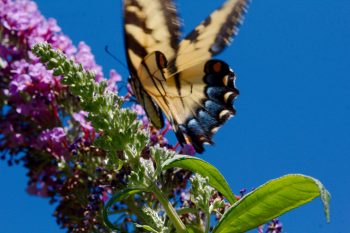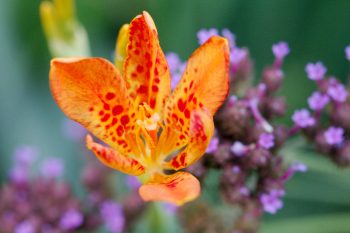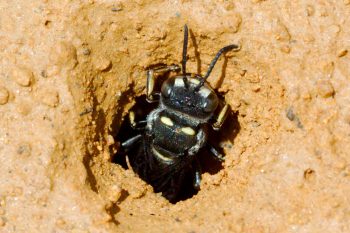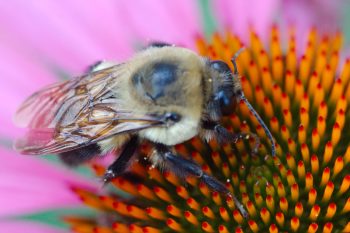I got a few insect photos today, including a few of large milkweed bugs (Oncopeltus fasciatus) on milkweed (Asclepias tuberosa), an eastern tiger swallowtail (Papilio glaucus) on buddleia flowers, an eastern bumble bee (Bombus impatiens) on a coneflower (Echinacea purpurea), and some sort of longlegged fly (family Dolichopodidae). Finally, I got some of this blow fly (family Calliphoridae) on scarlet beebalm (Monarda didyma). It’s not my favorite insect. In fact, I’d have to rank it in the bottom half rather than the top. I don’t mind wasps and bees in general but flies and particular what I consider to be the ‘annoying flies’ are in the negative side of the scale, along with mosquitoes and horse and deer flies. But their metallic green bodies are pretty cool, in spite of that.
Blow Fly on Monarda
Clivia in Bloom
Each spring we move our clivia (Clivia miniata, also known as Natal or Kaffir lily) into a shady spot in our back yard. It cannot take the summer sun and so it needs to be in a protected spot but it’s also best if it’s in a place that will get rain (if we have any) because we sometimes forget to water it. This is a fairly tollerant plant, though, and can actually take a little neglect. When I got it from a co-worker who was leaving the it had outgrown it’s container. It had also fallen over and out of its pot a few times. I repotted it into a larger pot and it is very happy, blooming most summers in the yard. This picture was taken after a rain storm.
Cathy on the Back Patio
Cathy plants annuals in pots for our back patio each year. Every year, however, they are needed less and less as a primary focus and more as accents under the increasingly dense wall of black-eyed Susans that grown around the perimeter. Many of the flower pictures that I take are of a a single flower or at most a few together. It’s good, from time to time, to see the bigger picture (so to speak) and look at the forest instead of the trees. Adding Cathy to the picture can’t hurt, either.
Cycnia tenera (Delicate Cycnia)
I went out to the empty lot next to my building this afternoon. I started by going through the woods on the lower part but then crossed the stream on a tree that conveniently fell across it. That saves me a bit of underbrush getting to the open, higher ground of the northeastern part of the lot. This part has only a few trees, so far, and is mostly filled with a thick covering of ragweed with milkweed and goldenrod scattered throughout. I happened to see this little moth, mostly white with a little orange on the leading edge of its wings. It is a delicate cycnia (Cycnia tenera) and is fairly shy. In the other two Cycnia species found in North America the orange or yellow on the wings is either absent (C. oregonensis) or is darker but doesnot extend to apex (C. collaris).
Flowers
This morning I took some pictures of a print that was left with us on Saturday for Tsai-Hong. It was made by one of Ralph’s caving friends who came to the memorial and it’s a somewhat impressionistic scene from a cave. But late this evening I realize I hadn’t taken any other pictures today and I didn’t want to post a picture of something that’s copyrighted as my photo of the day. In consequence, today’s picture is of some flowers that my mom got for the memorial and which have been on our dining room table since.
Deer and Heron
I went out to the woods next to my building this afternoon, towards the end of the day. After wandering around there a while without finding much of interest, I went down towards the tiny pond on the other side of the building and came across this white-tailed deer (Odocoileus virginianus) and great blue heron (Ardea herodias) sharing the watering hole together. The picture isn’t great but I’m happy I was able to get a picture of both of them before the both decided I had ruined the party and they left.
Sunset
I took a few pictures of flowers in the yard when I got home but then I went to my men’s meeting and on the way home stopped to take a few sunset pictures. This was taken from Veterans Park at the intersection of Veirs Mill Road and Rockville PIke, looking west (obviously). I like that there is some color reflected in the building on the left. We haven’t had a lot of spectacular sunsets lately so we’ll take what we get. That’s one feature of the spring and fall that I particularly like, though, along with the cooler temperatures, of course.
Sushi Damo
With a very few exceptions, I like pretty much all the seafood I’ve had the opportunity to try (but ask me about Kæstur hákarl sometime). This includes pretty much any sushi and sashimi I’ve had. I particularly enjoy sashimi because of the delicate flavors of the various fish. I think my favorite is mackerel (although I’m not sure ‘delicate’ is the right adjective for the flavor of mackerel) so that’s the star of this plate. The salmon and salmon roe were both good, too. This was our second plate of three and all the food we had was delicious. As for Sushi Damo as a restaurant, I’d say that while the food is as good as you’d expect, it isn’t necessarily better than places that are a bit less expensive. So, not my new favorite for sushi, but still good.
Skipper
The skippers are out in force these days. I got one picture with three of them on a single bunch of flowers. They move around a lot, making it a little harder to get a good picture but there are so many of them you can almost pick a flower and wait for one to land on it. They are somewhat plain as butterflies go. The butterflies and skippers are grouped together in the superfamily Papilionoidea under the order Lepidoptera. The other superfamilies (there are quite a few) are all moths.
Theresa and Maureen
We had the memorial gathering for Ralph today at our house and it was wonderful and sad and good and difficult and fun and exhausting. We had (at best count) 108 people in our house between 2:00 and 6:00 PM (but not quite that many at any given time). That’s a pretty good crowd and it was really nice to meet some of the folks Ralph worked with and even more of the folks he caved with. We could not have done it without the selfless help of a few really good friends and these two were amazing. They had never met before today but I was sure they were going to hit it off. They did and it wasn’t long before they were tag-team teasing me. Thanks to all who helped and to all who came to remember Ralph, brother, son, father, grandfather, caver, robotics vision expert, and all around nice guy.
Eristalis tranversa (Transverse Flower Fly)
I was off work yesterday and today, getting ready for the gathering coming up tomorrow. I still took a break each day to get pictures. Before I had gotten very far into the backyard this afternoon I spotted this transverse flower fly (Eristalis tranversa) on a black-eyed Susan Rudbekia sp.). It’s a pretty little fly and the color pattern on its abdomen is quite distinctive. They especially seem to like the black-eyed Susans with which they match quite well. I didn’t have very good lighting for most of the pictures I took but managed to get a few (including this one) with a single on-camera flash that turned out a bit better.
Melittia cucurbitae (Squash Vine Borer)
I went out to take pictures of a carpenter bee this afternoon but before I got to where she was, I saw this moth, a squash vine borer (Melittia cucurbitae), on the Herrenhausen oregano (Origanum laevigatum ‘Herrenhausen’). It’s not a terribly good specimen. Much of the orange on its abdomen has been rubbed off, but it’s a pretty distinctive little clearwing moth (family Sesiidae). I got some good photos of the carpenter bee, as well, but since I’m almost certain to have more photos of those I decided to post this one instead.
Oncopeltus fasciatus (Large Milkweed Bug)
The butterfly weed (Asclepias tuberosa) is in bloom and it’s a lovely, orange accent in the back of the garden. I’d be happy to have more of this, either the standard orange or the lovely, yellow variety. I’d also like to get some Asclepias curassavica, known as blood flower, although that’s not winter hardy anywhere near this far north. It can, apparently, be grown easily as an annual from seed. I might also try to get some Asclepias purpurascens, commonly called purple milkweed. It’s a native and I am pretty sure I’ve seen it at the farm, so I could dig some up there or get some seeds.
The large milkweed bug (Oncopeltus fasciatus) is a common visitor to butterfly weed (one of the milkweed family) and is particularly well suited for hiding among the flowers of A. tuberosa.
Cupido comyntas (Eastern Tailed-Blue)
This little butterfly, an eastern tailed-blue (Cupido comyntas) is a fairly common visitor to our garden and can be seen throughout the region. It’s not the easiest butterfly to photograph, partly because of it’s diminutive size (it’s small) and partly because it’s a fairly shy critter and doesn’t like being approached. But this one let me get close enough for a pretty good shot. It was late enough in the day that the light wasn’t as good as I’d have liked and this was taken with the aid of the camera’s on-board flash. It isn’t the best lighting for small subjects but in this case it worked out reasonably well.
Mushroom
I’m not all that happy with this picture, but it’s what I have for today. We’ve had a pretty good run of insects and flowers, with a few people pictures interspersed among them. This mushroom appeared a couple days ago but today it was open. I took a bunch of pictures from the edge and then tipped it over so I could see the gills on the underside. Wikipedia describes a gill as “a papery hymenophore rib under the cap of some mushroom species.” I like that. I think from now on, I’ll call them papery hymenophore ribs.
Tiger Swallowtail (Papilio glaucus) on Buddleia
Once the buddleia comes into bloom, which has happened in the last week or so, it’s a rare day when there isn’t at least one tiger swallowtail (Papilio glaucus) fluttering around the yard. They aren’t anywhere as near as common and the many skippers (family Hesperiidae) that we have by the dozens or even as the cabbage whites (Pieris rapae), but pretty common. And of course they are much more striking. I particularly like then when the sun is on them or even shining through them and they are against a clear, blue afternoon sky, as this one is. The color on the upper side of the hindwings identifies this as a female, just in the act of taking off from the flower.
Iris domestica
This is the so called blackberry lily, formerly known as Belamcanda chinensis but now renamed to Iris domestica. It’s a pretty little thing. each individual bloom lasts a day (or a fraction of a day, really) but they come one after the other for a nice, long while. They are, as you can see, very eye-catching. Each year we collect the seeds from them and scatter them around in other parts of the garden. Of course, they get moved by birds, as well. This is a seedling, growing on the edge of a garden bed in the center of our back yard, among the Verbena bonariensis, with which it contrasts very nicely.
Cerceris fumipennis
After taking the picture of the lady beetle larva in the woods, I crossed the stream on a fallen tree trunk. I worked my way from there through a fairly dense area of brambles and small trees to the slope that leads to what I call the uplands part of the empty lot. This is about 30 feet higher than the lowlands across the stream and it is mostly clear of trees. It is filled with ragweed and milkweed with a few empty spots that are almost barren, with just bare clay which sometimes holds standing water and other times is baked into a cracked, hard surface. In one of those empty spots, I followed this wasp, which is Cerceris fumipennis, an apoid wasp (Apoidea) in the family Crabronidae. It landed and disappeared into this little hole in the ground. I figured it would eventually come out again so I got down and waited. I was rewarded for my patience when he appeared at the entrance and was able to get a half dozen shots off before he flew off into the distance.
Lady Beetle Larva
It was a beautiful, if somewhat hot afternoon today and I went out into the woods next to my building. As I walked through the underbrush under the sycamore, tulip poplar, redbud, walnut, and black cherry trees, I noticed this little creature on a leaf. This is the larva of a lady beetle. The family Coccinellidae, the lady beetles, has about 6,000 species in 360 genera worldwide and nearly 500 in eastern North America. I have no idea to which of those this larva belongs and I’m not even going to try to figure it out. The adults are generally easier to narrow down but to me, anyway, the larva are just too much alike. I found a key to the larva of North American lady beetles but it starts out as follows. Tell me how helpful this is to you:
Mandible with digitiform teeth, retinaculum absent; terga with scoli, sometimes with parascoli; frontoclypeal suture complete; antenna long, 3 or more times as long as wide, of nearly uniform diameter.
Bumblebee on Coneflower
I didn’t get out of the office today to go take pictures. Most of the day it was raining and then I just didn’t have time in the afternoon. I was a little busy but actually more frustrated than anything else, so going out would have been nice. Nevertheless, when I got home I took some pictures of a common eastern bumblebee (Bombus impatiens) on one of the purple coneflowers (Echinacea purpurea) outside our dining room window. I like bumble bees and they are out in pretty good numbers right now. In prior years it seemed that they were outnumbered by carpenter bees (Xylocopa virginica). This year I’m seeing a lot more bumblebees. That’s just anecdotal evidence, of course but that’s the way it seems to me.

